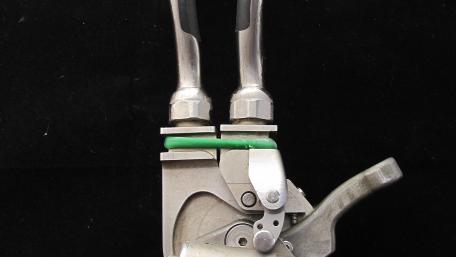A durable and easy-to-use prosthetic device that provides different grasping modes for daily tasks
Body
This study is complete and is no longer recruiting subjects.
Many thousands of individuals in the United States are living with loss of their arm and/or hand, including military service personnel injured in combat. Most people experience arm amputation because of an accident or other trauma, and are overwhelmingly young and active.
Despite the emergence of robotic prostheses, many people with upper-limb loss still prefer using body-powered devices, where they use the motion of their body (typically shoulder movement) to operate the prosthesis through a harness and cable system. These individuals typically choose to use a prehensor (e.g., a split hook or other device used for grasping), rather than a hand, as they are generally light, durable, and functional.
Currently, two types of body-powered prehensors are available: voluntary open (VO) devices, in which the user exerts force through the cable system to open the device; and voluntary close (VC) devices, in which pulling on the cable closes the device. VO devices only provide a weak grasp force (e.g., for holding light objects), but are easy to use. VC devices enable the user to apply large grasp forces but require the user to maintain tension in the cable to hold an object.
With previous funding from the National Institute on Disability, Independent Living, and Rehabilitation Research (NIDILRR), we developed an innovative prehensor that provide both VO and VC modes through a simple manual switching system. This VO/VC device can be used in the VO mode for grasping or holding light objects and switched to VC mode to provide a high grasp force, when needed.
The goal of this project was to evaluate the clinical utility of the VO/VC prehensor by objectively quantifying whether people choose to use both modes while performing in their home environments.
We integrated force sensors into subjects’ harnesses so that we could record use of the prehensor at home—forces exerted, time worn, and number of times used—in individuals with transradial amputations who were VO or VC users. Then we prompted them to switch the device for different tasks at home. Finally, we stopped prompting and just monitored usage, to see if they continued to use both modes of the device. We also asked them about the device using a questionnaire.
Many users found that the VO/VC was not strong enough in both modes, which was due to design limitations that we addressed in our final design. Several participants also found the device heavy compared to the lightweight Hosmer hooks.
Despite these limitations, all study participants chose to switch device modes while completing in-lab assessments. At home, 3 out of 4 study participants switched the device at least 5% of the time, and all switched a minimum of 7 times/day without prompting, suggesting that having two modes was useful.
All subjects were enthusiastic about the concept and indicated they would be interested in such a device if commercially available.
Another issue raised by users was that switching between modes using a mechanical switch was cumbersome. Switching would also likely be especially difficult for individuals with bilateral amputations. To address this issue, we have begun development of a switch controlled by the biomedical (EMG) signals that occur when a muscle contracts, which would be more intuitive to use and would not interrupt task performance. The electrode(s) would be placed in the prosthetic socket, as in a conventional myoelectric device.
Publications & Presentations
Body
Papers
Sensinger JW, Lipsey J, Thomas A, Turner K. Design and evaluation of voluntary opening and voluntary closing prosthetic terminal device. Journal of Rehabilitation Research & Development. 2015 Jan 1;52(1).
Conference Presentations
Sensinger J, Lipsey J, Thomas A. VOVC Body-powered hand with multiple grasp patterns. ISPO June 22-25, Lyon, France.
Swartz A, Turner K, Jayaraman A, Sensinger J. Evaluation of daily use and function of conventional body-powered prostheses and custom VO/VC terminal device. Accepted Podium presentation Myelectric Controls Symposium (MEC) ‘17, August 2017, Fredericton, NB, Canada.
Patents
Gripping device with switchable opening modes, Sensinger, J. US Patent # US9,861,499. Issued 1/9/2018.
Body
The contents of this webpage were developed under a grant from the National Institute on Disability, Independent Living, and Rehabilitation Research (NIDILRR grant number 90RE5014-02-00). NIDILRR is a Center within the Administration for Community Living (ACL), Department of Health and Human Services (HHS). The contents of this webpage do not necessarily represent the policy of NIDILRR, ACL, HHS, and you should not assume endorsement by the Federal Government.

